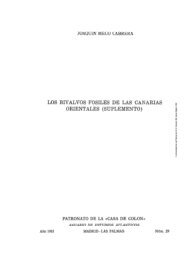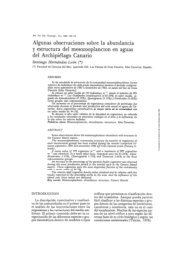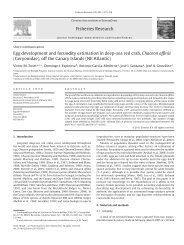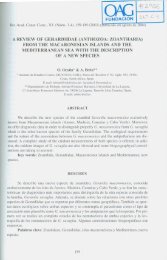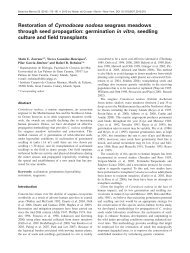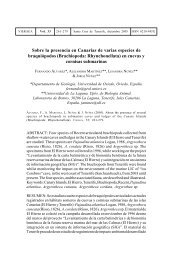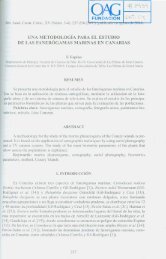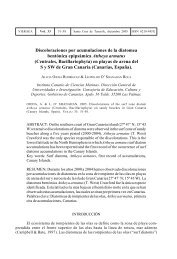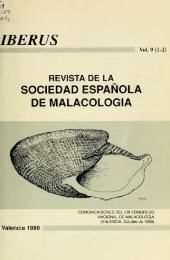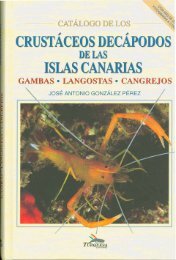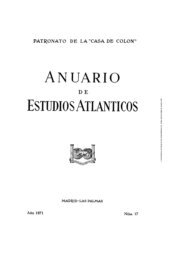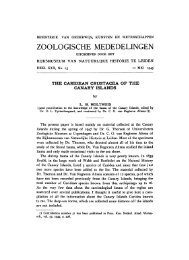of the madeira and selvagens archipelagos - redmic
of the madeira and selvagens archipelagos - redmic
of the madeira and selvagens archipelagos - redmic
Create successful ePaper yourself
Turn your PDF publications into a flip-book with our unique Google optimized e-Paper software.
Resumo<br />
1. Os fungos desempenham um papel fundamental na manutenção<br />
dos ecossistemas, intervindo na formação do<br />
solo, na reciclagem dos nutrientes, na decomposição da<br />
<strong>madeira</strong>, no crescimento das plantas e na limpeza das<br />
florestas.<br />
2. Apesar de mal conhecidos, os fungos são uma importante<br />
componente da biota madeirense.<br />
3. Tendo por base unicamente a literatura publicada, foram<br />
compilados 743 taxa de fungos para a região, pertencentes<br />
a 61 ordens, 146 famílias e 349 géneros.<br />
4. Os fungos conhecidos dos arquipélagos da Madeira e<br />
Selvagens estão assim distribuídos: 738 para a Ilha da<br />
Madeira, 14 para Porto Santo, 4 para as Desertas e 3<br />
para as Selvagens.<br />
5. As Agaricales constituem o grupo que apresenta maior<br />
diversidade, incluindo 200 espécies e subespécies. O género<br />
mais diverso é o género Puccinia, com 46 taxa.<br />
6. A micobiota da Madeira e Selvagens foi comparada com<br />
a de outros arquipélagos da Macaronésia, apresent<strong>and</strong>o<br />
um grau de similitude maior com a das Canárias.<br />
1. Introdução<br />
Segundo a 9.ª edição do Ainsworth & Bisby’s Dictionary<br />
<strong>of</strong> <strong>the</strong> Fungi (Kirk et al. 2001), os fungos são organismos eucariotas,<br />
heterotróficos, ubiquistas e cosmopolitas, constituídos<br />
por filamentos ramificados (hifas) ou, raramente, por<br />
células simples, que se reproduzem por esporos.<br />
Tradicionalmente, chamamos fungos a organismos que,<br />
na verdade, pertencem a 3 diferentes reinos: Chromista, Protozoa<br />
e Fungi. As estimativas quanto ao número global de<br />
CAPÍTULO 3 | CHAPTER 3<br />
OS FUNGOS (FUNGI) DOS ARQUIPÉLAGOS<br />
DA MADEIRA E DAS SELVAGENS<br />
THE FUNGI (FUNGI) OF THE MADEIRA<br />
AND SELVAGENS ARCHIPELAGOS<br />
Ireneia Melo & José Cardoso<br />
Jardim Botânico, Museu Nacional de História Natural, Universidade de Lisboa, Centro de Biologia Ambiental, R. da Escola Politécnica, 58,<br />
1250 -102 Lisboa, Portugal; e -mail: mimelo@fc.ul.pt<br />
57<br />
Abstract<br />
1. The Fungi play a fundamental role in ecosystem sustainability,<br />
as agents in soil formation, nutrient cycling, wood<br />
decomposition, plant growth <strong>and</strong> forest cleaning.<br />
2. Although poorly known, Fungi are an important component<br />
<strong>of</strong> <strong>the</strong> Madeira <strong>and</strong> Selvagens isl<strong>and</strong>s’ biota.<br />
3. Considering only <strong>the</strong> published literature, 743 taxa <strong>of</strong><br />
Fungi were recorded, belonging to 61 orders, 146 families<br />
<strong>and</strong> 349 genera.<br />
4. The Fungi reported from Madeira <strong>and</strong> Selvagens <strong>archipelagos</strong><br />
are distributed as follows: 738 species <strong>and</strong> subspecies<br />
for Madeira, 14 for Porto Santo, 4 for Desertas<br />
<strong>and</strong> 3 for Selvagens isl<strong>and</strong>s.<br />
5. Order Agaricales, with 200 species <strong>and</strong> subspecies,<br />
showed <strong>the</strong> highest taxa diversity. The genus with <strong>the</strong><br />
highest number <strong>of</strong> species <strong>and</strong> subspecies is Puccinia,<br />
with 46 taxa.<br />
6. The mycobiota <strong>of</strong> <strong>the</strong> Madeira <strong>and</strong> Selvagens <strong>archipelagos</strong><br />
was compared with that <strong>of</strong> o<strong>the</strong>r Macaronesian<br />
<strong>archipelagos</strong>; <strong>the</strong> Canary Isl<strong>and</strong>s showed <strong>the</strong> highest similitude<br />
in Fungi composition.<br />
1. Introduction<br />
According to <strong>the</strong> 9th edition <strong>of</strong> <strong>the</strong> Ainsworth & Bisby’s<br />
Dictionary <strong>of</strong> <strong>the</strong> Fungi (Kirk et al. 2001), Fungi are eukaryotic,<br />
heterotrophic, ubiquitous <strong>and</strong> cosmopolitan organisms,<br />
composed <strong>of</strong> branching filaments (hyphae) or, more rarely,<br />
<strong>of</strong> single cells, reproducing by spores.<br />
Commonly, organisms belonging to three different kingdoms,<br />
Chromista, Protozoa <strong>and</strong> true Fungi, are called Fungi.<br />
Estimates <strong>of</strong> <strong>the</strong> global number <strong>of</strong> Fungi species vary



